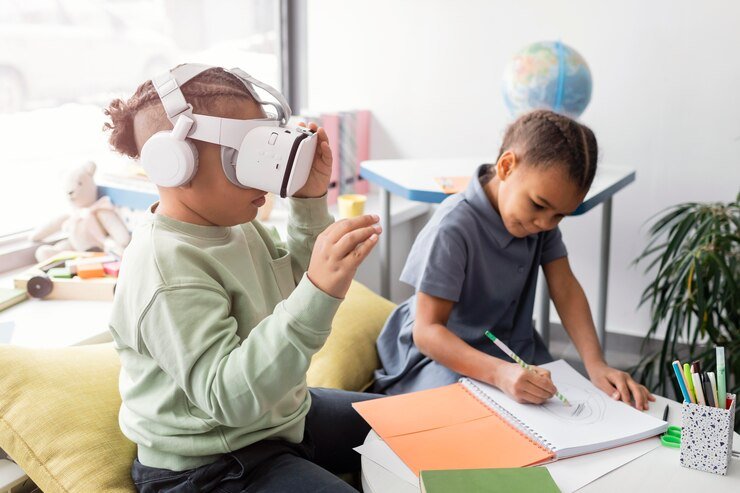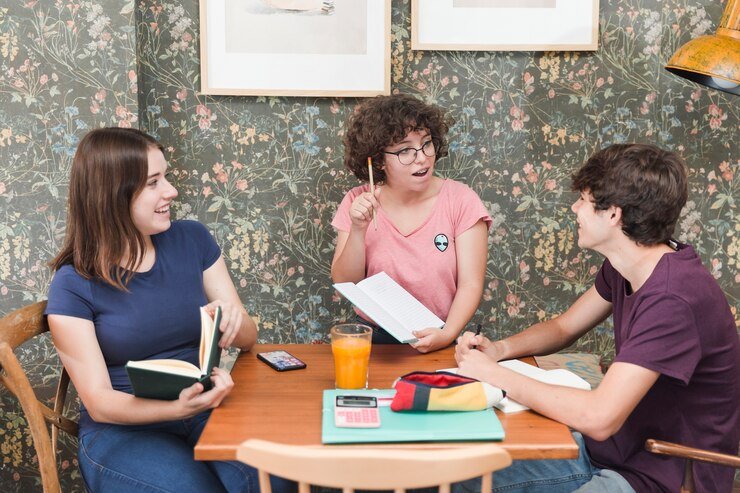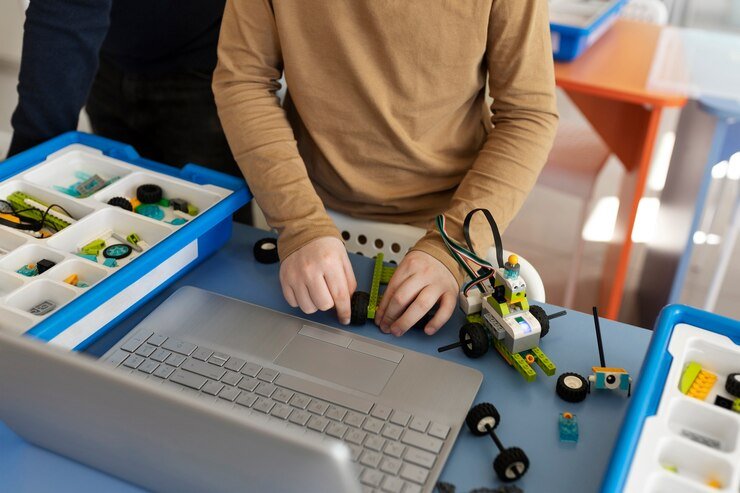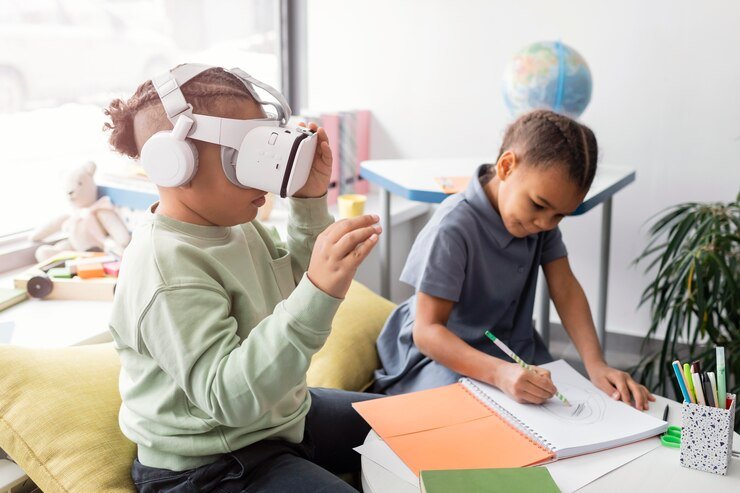Educational technology (edtech) is changing how students learn in exciting ways. It brings interactive tools and personalized learning to classrooms. This makes learning more engaging and helps students develop important skills for the future.
By using these tools, students can improve their communication, teamwork, and problem-solving. They also get to be more creative. This means they are ready for the challenges of a digital world where change is constant.
Key Takeaways
- Educational technology plays a crucial role in promoting creativity and innovation in the classroom.
- Edtech enables students to engage in the 4Cs of 21st-century learning: communication, collaboration, critical thinking, and creativity.
- Digital tools and platforms provide opportunities for students to explore, express, and bring their ideas to life in innovative ways.
- Integrating edtech into the curriculum helps students develop future-ready skills for success in the digital age.
- A student-centered approach to edtech fosters a dynamic and engaging learning environment.
Unlocking Creativity with Educational Technology
In the 21st century, educational technology is crucial for sparking creativity in the classroom. It uses digital tools to help students grow their creative skills. This is important for their future success.
Fostering the 4Cs of 21st-Century Learning

Educational technology helps students with four important skills. These are communication, collaboration, critical thinking, and creativity. By making multimedia projects and working together on digital tasks, students learn to think critically and bring their ideas to life.
Exploring Digital Tools for Creative Expression
There are many digital tools that let students show their creativity. These range from apps for making videos to software that lets students work together. Using these tools helps students become good at digital skills and problem-solving.
“Creativity is as important in education as literacy, and we should treat it with the same status.”
– Sir Ken Robinson
Using technology in teaching boosts both creative thinking and 21st-century skills. It prepares students for a fast-changing world.
In the end, Educational technology opens up many creative doors. It teaches students to innovate, solve problems, and work together. These are key skills for thriving in the modern age.
Seesaw: A Versatile Platform for Student Creativity
In today’s world, technology plays a big part in education, especially when it comes to letting students show off their creativity. Seesaw is a popular platform that connects classrooms. It lets students share their ideas, work together, and show what they’ve learned in unique ways.
Word Problems and Feedback
On Seesaw, students can make and solve math problems while using cool features to make their work fun to look at. They can add voice or video to explain, use pictures, and get feedback right away from teachers and friends. This makes learning math more engaging and helps them become better problem solvers.
Grammar Talks and Collaboration

Seesaw is great for working together, especially for language arts. Students can join “Grammar Talks” to chat about grammar and help each other understand the rules. This not only makes learning more fun but also teaches important skills such as how to communicate and work as a team.
ePortfolios and Math Work
But Seesaw is not just for English. It’s also perfect for showing off in math. Students can make digital math portfolios to record how they solve problems and the cool ways they found to answer them. This lets them share their math skills with everyone in a fun and easy way.
Seesaw is amazing for teachers as well. It helps them make learning fun and interactive. It encourages creativity and teamwork in students. With Seesaw, learning becomes a journey full of creative and exciting stops, making school more fun for everyone involved.
Flip: Empowering Student Voice and Presentation Skills
Flip is changing the game in educational technology, making a big difference. It allows students to grow their voice and improve how they present information. They get to share what they know using various digital tools, like podcasts, commercials, and how-to videos.
By using Flip, students can become great storytellers and creators of digital content. They can make exciting podcasts to share their views, making their voice strong. Creating cool commercials helps them learn about branding, messaging, and how to present things well.
But Flip doesn’t stop there. It also lets students make how-to videos to show their knowledge in a specific topic. This kind of digital storytelling helps them learn more deeply and feel proud of what they’ve learned.
Flip also makes it easy for students to work with others worldwide. They can get international pen pals and make weather reports together. This helps them communicate better and see things from a global angle.
By letting students be creative with video making and other tools, Flip is preparing them for future jobs. It’s giving them skills they’ll need as things change in the working world.
“Flip gives students the freedom to showcase their ideas and talents in ways that traditional classrooms can’t always accommodate. It’s a powerful tool for unlocking creativity and amplifying student voice.”
Integrating Educational Technology for Creativity

Adding edtech integration for creative classroom projects needs a careful plan. Teachers can use the wide variety of online resources and social media to boost creativity. They should introduce these edtech tools slowly. This helps everyone, teachers and students, to learn how to use them well.
Utilizing Online Resources and Social Media
The internet is full of online resources that spark creativity. You can find educational sites, digital trips, and tools to share ideas. Social media is also great for creativity. It lets students show their work and chat with friends about it.
A Gradual Approach to Mastering EdTech Tools
Starting with new technology adoption may seem hard, but a slow start is better. Teachers should first understand how to use edtech tools well. Then, they can help their students do the same. Doing this step by step makes using these tools more effective and fun for everyone.
Taking things slowly when mixing technology into education is a smart move. It helps students show their creative side and makes learning more engaging.
“Integrating educational technology is not about the tools, it’s about the pedagogy. When used effectively, technology can be a powerful catalyst for creativity and innovation in the classroom.”
Living with a Creative Mindset
Having a creative mindset is key to unlocking your innovative side. Those who are open to growth and willing to take risks often see failure as a chance to learn. This opens doors to new ideas and helps solve unique problems. A creative mindset can lead to thinking beyond the norm and improve different areas, like education.
This mindset is all about risk, new ideas, and solving problems without fear. They don’t avoid challenges but welcome them as chances to get better. Failure is just a part of finding new solutions and can actually lead to major discoveries.
Building a growth mindset is important for being creative and innovative. This way of thinking focuses on the idea that you can get better through hard work. By believing in growth, you’re more likely to tackle harder tasks, keep trying even when it’s tough, and always aim to get better.
To truly have a creative mindset, you need to balance risks, bounce back from failure, and be open to change. Growing these skills helps you reach your full potential. It can make a big impact in areas like education, pushing things forward.
Creativity in the Classroom: Striking a Balance
Creativity in education is crucial for student success. But, we must balance it with traditional teaching and rule-compliance. Focusing only on memorization and following rules can stop students from being creative. This includes things like taking risks and thinking for themselves.
But, too much focus on creativity can have negative effects if it leaves out the need for good behavior and following rules. The goal is to find the perfect mix. Students should be free to explore their creative side, but also ready for the demands of school and work.
“Creativity is not just about coming up with new ideas, but also about having the discipline to see them through. A balance between creative expression and rule-compliance is essential for a well-rounded education.”
This balance helps create a learning space that grows both creativity and practical skills. It prepares students for the diverse challenges they will face. They can be innovative and still understand and meet the demands of a structured system.
The ultimate aim is to make students complete in their skills. They should be able to think creatively but also know why following rules is important. This balance is the secret to making creativity in education work.
The Use of EdTech in Learning
EdTech has changed how we learn, making room for creativity and innovation. Makerspaces are key in this change. They’re areas that help students work on projects. This includes tools, materials, and tech for creative and collaborative work.
Makerspaces and the Intersection of Creativity and Technology
Makerspaces mix simple tools with high-tech gadgets. This mix boosts creativity and tech understanding. Students can try out their ideas and learn important skills like solving problems, thinking critically, and teamwork.
In Makerspaces, students get to be curious and try out new things. They learn by making mistakes and fixing them. This way, they become more creative and open to facing challenges.
In Makerspaces, educational tech tools add more chances for creativity. Students can design and make new things with 3D software. They can also make videos to show off their work in new ways.
Combining EdTech and Makerspaces is key for education’s future. It helps students take charge of their own learning. They also develop skills needed today, helping them succeed in the future.
Fostering Creativity in Children
Cultivating creativity in kids is vital for future innovators. Sir Ken Robinson, a famous speaker, says kids have immense talent. They’re not worried about being wrong yet. This makes them natural innovators.
To unlock kids creativity, it’s essential to encourage them to think differently from a young age. They should also feel free to explore, imagine, and take risks. Teachers should create an environment where mistakes are learning opportunities.
In the classroom, celebrating creativity can lead to amazing breakthroughs. Giving kids the tools to express their ideas is crucial. When children are free to think in new ways, they start to solve big problems and make progress in many areas.
Also Read: Institute Of Culinary Education – Top Culinary School
Nurturing Divergent Thinking from a Young Age
Encouraging kids to think differently is crucial for their creativity. This means showing them many points of view and feeding their curiosity. It also involves making a space where mistakes are safe and used as lessons.

